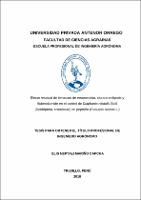Efecto residual de benzoato de emamectina, clorantraniliprole y flubendiamide en el control de Diaphania nitidalis Stoll (lepidóptera, crambidae) en pepinillo (Cucumis sativus L.)

View/
Download
(application/pdf: 1.556Mb)
(application/pdf: 1.556Mb)
Date
2018Author(s)
Mariño Capcha, Elis Neptali
Metadata
Show full item recordAbstract
El presente trabajo de investigación se llevó a cabo en el ramal Pose el
Gato, en el caserío de Huancaco, distrito y provincia de Virú, a la altura del
km 513 de la Panamericana norte – La Libertad; tuvo como objetivo
principal determinar la residualidad de tres insecticidas basados en
benzoato de emamectina, clorantraniliprole y flubendiamide en el control de
Diaphania nitidalis Stoll (Lepidóptera, Crambidae) en pepinillo, variedad
Salvador F1. El diseño experimental utilizado fue el de Bloques Completos
al Azar (DBCA) con 4 tratamientos y 4 repeticiones. Las dosis empleadas
fueron: benzoato de emamectina (Proclaim, 0.125 Kg/ha, T1),
clorantraniliprole (Coragen, 0.125 L/ha, T2), flubendiamide (Takumi, 0.125
Kg/ha, T3) y un tratamiento testigo (sin aplicación). Antes de la aplicación
de los tratamientos ya existían posturas en las plantas, así como brotes
dañados por Diaphania nitidalis Stoll. A los tres días después de la
aplicación de los insecticidas, se registraron posturas y también hubo
brotes dañados, pero estadísticamente el efecto de los tratamientos con
insecticidas fue similar entre ellos, pero diferentes al testigo. No se
presentaron flores ni frutos dañados salvo en el Testigo (sin insecticida);
esta tendencia se mantuvo a lo largo de todas las evaluaciones realizadas
a los tratamientos. El efecto residual de benzoato de emamectina,
flubendiamide y clorantraniliprole en el control de Diaphania nitidalis stoll
(Lepidóptera, Crambidae) en pepinillo (Cucumis sativus l.) se mantuvo
hasta los tres días para las dos primeras moléculas y hasta los seis días el
clorantraniliprole, por lo tanto, la frecuencia de aplicación puede hacerse en
los límites de estos tiempos. La efectividad de las moléculas ensayadas es
estadísticamente similar, pero el clorantraniliprole tiene mayor residualidad. The present research work was carried out in the Pose el Gato branch, in
the village of Huancaco, district and province of Virú, at km 513 of the
Panamericana Norte - La Libertad; Its main objective was to determine the
residuality of three insecticides based on benzoate of emamectin,
chlorantraniliprole and flubendiamide in the control of Diaphania nitidalis
Stoll (Lepidóptera, Crambidae) in gherkin, variety Salvador F1. The
experimental design used was the Complete Random Blocks (DBCA) with
4 treatments and 4 repetitions. The doses used were: emamectin benzoate
(Proclaim, 0.125 Kg / ha, T1), chlorantraniliprole (Coragen, 0.125 L / ha,
T2), flubendiamide (Takumi, 0.125 Kg / ha, T3) and a control treatment
(without application). Before the application of the treatments there were
already postures in the plants as well as shoots damaged by Diaphania
nitidalis Stoll. Three days after the application of the insecticides, postures
were registered and there were also damaged shoots but statistically the
effect of the insecticide treatments was similar between them but different
from the control. There were no flowers or fruits damaged except in the
control (without insecticide); this trend was maintained throughout all the
evaluations made to the treatments. The residual effect of emamectin
benzoate, flubendiamide and chlorantraniliprole on the control of Diaphania
nitidalis stoll (Lepidóptera, Crambidae) on gherkin (Cucumis sativus) Was
maintained until three days for the first two molecules and up to six days the
chlorantraniliprole, therefore the frequency of application can be done within
the limits of these times. The effectiveness of the molecules tested is
statistically similar, but the chlorantraniliprole has greater residuality.
Subject
Collections
- Ingeniería Agrónoma [99]

